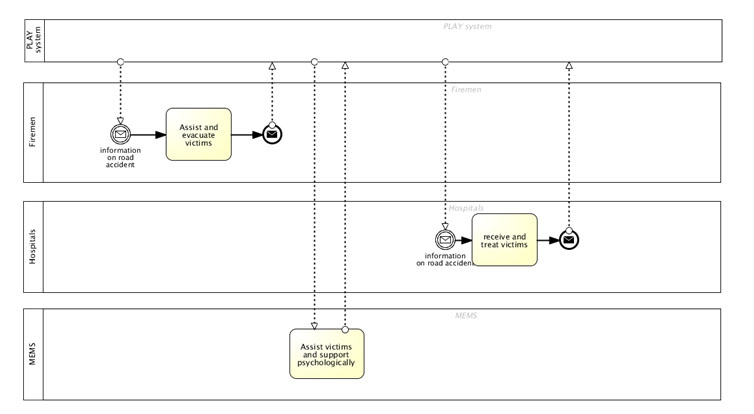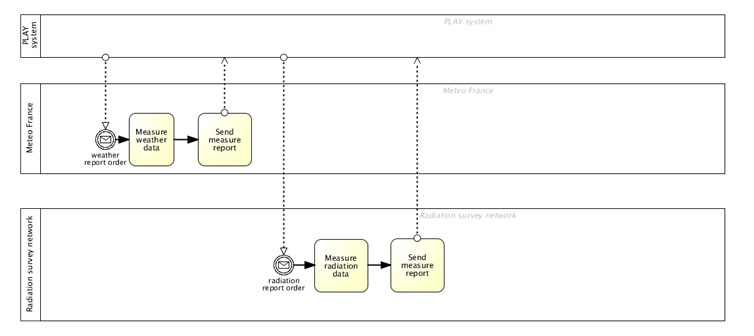Crisis Management Case Study
Contents
ToBe Analysis
S-Cube framework
The structure of the S-Cube use case description framework is based on three main parts:
- Business Goals (BG) and Domain Assumptions (DA): they describe objectives to be pursued (BG) and properties assumed to be true (DA). Each BG or DA is described through a specific table.
- Domain description: it describes the laws and specificities of the sub-part of the world in which the use case occurs. Usually, this domain description is based on several elements:
- A glossary: listing and describing the concepts of the domain.
- Domain model(s): describing the relations between concepts of the domain (the ones from the glossary).
- Laws: describing specific characteristics of the concepts of the domain (the ones from the glossary).
- Strategic dependency diagram and context diagram: describing dependencies and relations between actors of the domain.
- Scenario description: it is an operational description of the steps of the use case. It is described through tables (one per sub-scenario) containing actors concerned and textual description of the scenario. Furthermore, the sub-scenario might be also described with a model or a diagram.
Furthermore, we believe that an ontology could be built in order to ensure a large part of the domain description as described in section 2.3.5.1. Such an ontology could provide a list and a description of the concepts of the domain (glossary), the relations between these concepts (domain model) and the specific characteristics of these concepts (laws). Concerning the dependencies and relations between actors, a UML use case diagram will be used as described in section 2.3.5.2.
Finally, concerning the scenario description, the expected tables will be provided, completed with BPMN diagram to describe processes, as presented in section 2.3.6.
Source of the problem
The radiation leak in this scenario originates from the combination of two problems:
- The metal of the steam generator is very thin. Due to the wearing effect of time, a leak appeared in the steam generator. As a result, the water within the primary loop, contaminated, spreads through the secondary loop.
Consequences: The steam of the secondary loop is contaminated and the pressure within the secondary loop increases.
- The throttle valve, a safety device of the secondary loop, opens due to the increased pressure inside the secondary loop. It does not respond to the manual bypass of the safety loop, requiring its closure.
Consequences: The steam of the secondary loop, contaminated, escapes from the secondary loop to the atmosphere.
These problems are illustrated by Figure 7.
First problem: leak within the steam generator => contact between primary and secondary loopsThrottle valveSecond problem: throttle valve blocked open
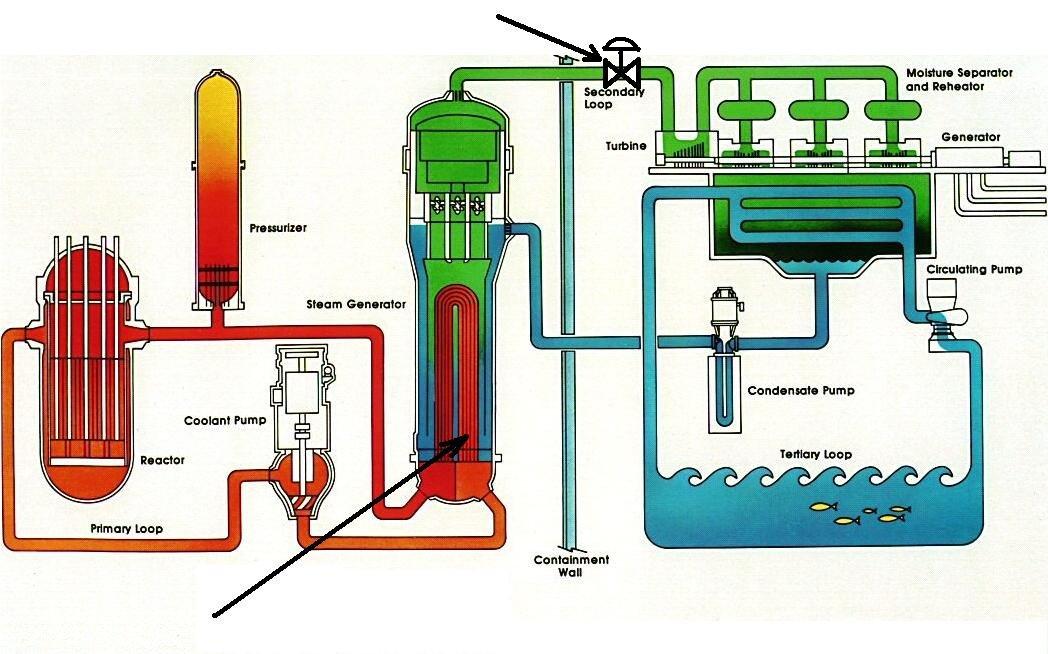
Crisis cell and actors
To resolve the crisis, many stakeholders are involved. The crisis cell, in charge of operation, is piloted by the prefect (representative of the national authority), outside the nuclear plant. Delegates of each actor are present in the crisis cell. Firemen, policemen, and any other actor involved in the response process has one representative in the crisis cell, to validate the feasibility of decisions, link with the field and ensure communication between actors. This crisis cell is distributed. Most of the decisions are made locally, where prefects and delegates are gathered, but decisions may also come from the national authority, local or national responsible of the nuclear plant or experts. (Cf. Figure 8).

Sequencing of activities
To simulate the response to a nuclear accident, a list of actions to be performed has been created. This table will serve as a basis for the first version of the scenario. Additional elements of complexity of the situation that better show the value added of PLAY system will be developed (see part 2.4 Workplan).
Legend of the table:
| Choreography (flow between 2 or more business processes) |
| Continuous or repetitive task |
| Timing | Actor | Crisis cell | Sensor | Event type | Event nature | Action | Processes |
|---|---|---|---|---|---|---|---|
| 12h | Leak within the steam generator => contact between primary and secondary loops | ||||||
| 12h10 | Nuclear Plant Teams (NP1) | pressure in the primary loop | Situation | Detection of the leak | to stop reactor (yet flows within primary and secondary loops continue) | ||
| 12h11 | throttle valve open /close sensor | Situation | Throttle valve opens | ||||
| 12h11 | Nuclear Plant Teams (NP1) | to require the closure of the throttle valve | |||||
| Situation | throttle valve does not respond to closing order | ||||||
| 12h11 | Consequence | Risk of radioactive leakage in the atmosphere | |||||
| 12h11 | Nuclear Plant Teams (NP1) | to alert responsible of nuclear plant | |||||
| 12h11 | Nuclear Plant Teams (NP1) | to send a technician to check valve status and manually close the valve if necessary | |||||
| 12h11 | Local responsible of the nuclear plant | to activate PUI | |||||
| Radiation Survey Network (NP2) | Situation | Confirmation of the leak | to confirm leak by measurements | ||||
| Local responsible of the nuclear plant | to call the representative of local authority (prefect) | ||||||
| Representative of the local authority | to activate PPI in reflex mode | To manage | |||||
| Local responsible of the nuclear plant | to alert populations (siren) | To respond | |||||
| 12h18 | Nuclear Plant Teams (NP1) | Situation | Throttle valve confirmed open by technician | ||||
| Local responsible of the nuclear plant | EDF local cell | to activate EDF local crisis management cell | To manage | ||||
| Local responsible of the nuclear plant | to call the representative of EDF national | ||||||
| National responsible of the nuclear plant | EDF national cell | to activate EDF national cell | To manage | ||||
| Representative of the local authority | to call the representative of national authority | ||||||
| Representative of the national authority | National authority cell | to activate national authority cell | To manage | ||||
| 13h | Local responsible of the nuclear plant | to contact media to inform that the PUI is activated | To manage | ||||
| Representative of the local authority | to alert field actors (firemen, police, army, office of infrastructure, radiation survey network, meteo france, Mobile emergency medical services, mayors) | To manage | |||||
| 12h20 | Local authority cell | to define safety perimeter | To manage | ||||
| 12h25 | Police (P) | Activity | to position safety perimeter | To respond | |||
| EDF local cell | to keep representatives of local and national authority informed | To manage | |||||
| 12h30 | Nuclear Plant Teams (NP1) | Situation | throttle valve blocked open, manual closure failed | ||||
| every min | Radiation Survey Network (NP2) | Situation | to measure radioactivity level and post information | To support | |||
| every min | Meteo France (MF) | Situation | to measure wind force and direction and precipitations + to post information | To support | |||
| 12h40 | throttle valve finally closed | ||||||
| Local responsible of the nuclear plant | to inform other cells that leak is stopped | ||||||
| Representative of the local authority | Local authority cell | to receive, synthesize and centralise information of each member of the cell | To manage | ||||
| Representative of the local authority | to provide instructions to cell members and spread information received from national authorities | To manage | |||||
| All field actors | to inform local authorities about operations updates and difficulties. | To respond | |||||
| Local authority cell | to define circulation plan | To manage | |||||
| Police (P) | Activity | to implement circulation plan | To respond | ||||
| Police (P) | Activity | to block access within the safety perimeter (10km around plant) | To respond | ||||
| Radiation Survey Network (NP2) | radioactivity | radioactivity level measured at 10 mSv | To support | ||||
| Representative of the local authority | to contact scientific cell to info about high radioactivity measure | To manage | |||||
| Scientific cell | to advise local authority cell to tell population to ingest iodine pill and wait for a risk to achieve 50mSv to send evacuation order | To manage | |||||
| 14h | Representative of the local authority | to decide that populations should ingest iodine pills | To manage | ||||
| 14h10 | Media | to inform populations that they should ingest iodine pills | To respond | ||||
| Mobil Emergency Medical Services (MEMS) | Activity | to distribute iodine pills to impacted population (for those, who did not already have pills) | To respond | ||||
| Impacted Population | to ingest iodine pills | To respond | |||||
| Radiation Survey Network (NP2) | radioactivity | radioactivity level measured at 20 mSv, increasing => risk to achieve 50mSv soon | To support | ||||
| Meteo France (MF) | wind, rain | wind : 5m/s, direction south westrain : 2mm/h | To support | ||||
| Scientific cell | to advice about evacuation perimeter and direction | ||||||
| 14h30 | Representative of the local authority | to decide to evacuate populations | To manage | ||||
| Local authority cell | to define evacuation perimeter | To manage | |||||
| Mobil Emergency Medical Services (MEMS) | Activity | to assist victims and support psychologically | To respond | ||||
| Media | to inform population that they have to evacuate | To respond | |||||
| Impacted Population | to make sure their accommodation is safe (switch off heating devices, etc.) | To respond | |||||
| Impacted Population | to evacuate by light vehicle or to go to the meeting point for bus evacuation | To respond | |||||
| Representative of the local authority | Resource | to requisition buses | To support | ||||
| 15h | Private Companies | Activity | to send buses to meeting point | To respond | |||
| 15h20 | Police (P) | Road works on the main road created a traffic jam | to inform local authority cell that there is a traffic jam on the main road | To respond | |||
| Local authority cell | to modify circulation plan | To manage | |||||
| 15h55 | Accident on the secondary road | to inform local authority cell that there is an accident | To respond | ||||
| 16h | Local authority cell | to send firemen to assist victims | To support | ||||
| 16h10 | Local authority cell | to re-modify circulation plan | To manage | ||||
| 16h15 | Police (P) | Activity | to implement third circulation plan | To respond | |||
| 16h30 | Firemen (F) | Activity | to assist and evacuate victims | To respond |
Business goals and Domain Assumptions
Extracted from the edSIPOC model (As-Is description of the use case), the following Business Goals and Domain Assumptions have been selected for the To-Be model:
| | |
| |
|
| |
NuclearUC-BG-01 |
| |
To plan and control relief process and means |
| |
Business Goals. |
| |
To execute Global Emergency Plan (PPI)
To mobilize protection and relief resources To communicate with media and local authorities To animate crisis management cell |
| |
Decisions have to be made to solve as fast as possible the nuclear accident in one hand, and to limit consequences of this accident on the other hand |
| |
Representative of the national authority
Representative of the military authority Scientific cell Meteo France Firemen Police Mobile emergency medical service French army Office of infrastructure Media Mobile measurement station |
| |
Must have. |
| | |
| |
|
| |
NuclearUC-BG-02 |
| |
To protect population |
| |
Business Goals. |
| |
To alert / communicate
To confine To distribute (iodine capsules) To evacuate To forbid |
| |
To keep the number of victims as low as possible |
| |
Radio France
Firemen Police Mobile Emergency medical services French Army Media |
| |
Must have. |
| | |
| |
|
| |
NuclearUC-BG-03 |
| |
To provide aid for employees and populations |
| |
Business Goals. |
| |
To decontaminate
To extinguish fire / explosion To rescue people after an accident To support psychologically To find new accommodation |
| |
To limit the consequences of the crisis |
| |
Firemen
Police Mobile emergency medical service French Army |
| |
Must have. |
| | |
| |
|
| |
NuclearUC-BG-04 |
| |
To back repairing and relief operations |
| |
Business Goals. |
| |
To secure perimeter
To make available resources / means |
| |
To support all crisis response operations |
| |
Nuclear plant teams
Representative of the national authority Radio France Firemen Mobile emergency medical service Hospitals Police Office of infrastructures |
| |
Must have. |
| | |
| |
|
| |
NuclearUC-BG-05 |
| |
To assess situation |
| |
Business Goals. |
| |
To measure radioactivity
To measure weather characteristics (wind velocity/direction, rain, etc.) |
| |
To assess the situation continuously |
| |
Nuclear Plant teams
Meteo France Radiation survey network Firemen Measuring equipment Mobile measurement station |
| |
Must have. |
| | |
| |
|
| |
NuclearUC -DA-01 |
| |
Deal with public opinion |
| |
Domain assumption |
| |
Nuclear accidents attract media attention. The situation may become even more complex, in cases where public opinion is not properly informed. |
| |
Media
Representative of the national authority |
| |
Radio, TV, loudspeakers |
| | |
| |
|
| |
NuclearUC -DA-02 |
| |
Service oriented application for all. |
| |
Domain assumption |
| |
Actors involved are heterogeneous and come with their own information systems. To ensure fast and effective communication, service oriented architecture is provided. |
| |
All |
| | |
| |
|
| |
NuclearUC -DA-02 |
| |
Focus on management, operations and support outside the nuclear plant |
| |
Domain assumption |
| |
The repairing of the nuclear plant, managed by a separate crisis cell, is out of the scope of our study |
Domain description
As explained in section 2.3, the domain description part of the adapted S-Cube model will be covered by (i) an ontology to describe concepts of the domain, relations between these concepts and characteristics of these concepts and (ii) a UML use case diagram to describe the actors and the relations between actors.
Ontology
Many definitions of an ontology have been given over past years (Gruber 1995, D8.1 InterOp 2004, Grimm et al. 2007): an ontology defines the basic terms and relations comprising the vocabulary of a topic area as well as the rules for combining terms, and relations to define extensions to the vocabulary (Neches et al. 1991). From this definition, an ontology includes not only the terms that are explicitly defined in it, but also the knowledge that can be inferred from it. More simply an ontology may be seen as a formal explicit specification of a shared conceptualisation for a domain of interest. This vision of ontology encompasses several interesting aspects which are:
A formal aspect: an ontology is expressed in a knowledge representation language that provides formal semantics.
An explicit aspect: the type of concepts used and the constraints on their use are explicitly defined.
A sharing aspect: This means there is some kind of agreement among people in a community or systems regarding the ontology.
A conceptualisation aspect: an ontology specifies knowledge in a conceptual way in terms of symbols representing concepts and their relations.
A domain specificity: the specifications in an ontology are limited to knowledge about a particular domain of interest. Ontology is referred to as a representation of knowledge that can be used and reused in order to facilitate the comprehension of concepts and relations as well as the communication between different domain actors.
In the PLAY project, this ontology was needed to represent, in a flexible and computable manner, the knowledge linked to domain and concepts of the use case (cf. S-Cube framework)
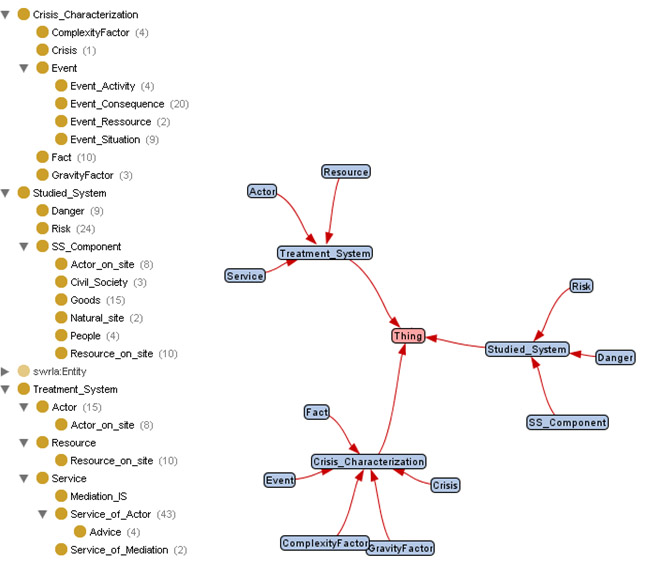
This ontology in Figure 9 and Figure 10 is composed of three main parts: studied system, crisis characterization, and treatment system.
The studied system is defined as the sub-part of the world affected by the crisis. The Studied system components have been grouped in different categories that should be considered as the basic concepts of a domain specific language, such as goods, natural sites, people and civil society. Goods can be seen as man-made entities (roads, bridges, buildings, houses ...). Opposite to Natural sites, which are not man-made, such as rivers, forests... People concern all the groups of persons that may be impacted by the crisis (people from a city, group of travelers, employees of a company, ...). Civil society includes social entities like media, intellectuals, associations and organizations that act in the crisis area.
The studied system also includes Risks and Dangers. A danger is a particularity of the considered sub-part of the world that might engender some particular risk. For example, an area like Japan presents a characteristic of seismic instability (danger) responsible for earthquake (risk).
Once appeared, a Crisis is composed of four main components: (i) facts, (ii) events, (iii) Complexity factor(s) and (iv) Gravity factor(s).
Facts are what happen in the field. A complexity factor is a characteristic that impacts directly the nature of the crisis and can affect its type (for example, a sanitary crisis may evolve into a social crisis due to the "over-communication" through the media). A gravity factor is a characteristic that impacts directly the gravity of the crisis (for example, a strong wind could increase the gravity of a fire in a forest whereas rain could decrease it).
Events are of four natures:
- Events "situation" refer to measurements taken from the field (radiations, wind velocity and direction, rain), at a given place and time.
- Events "Resources" refer to the status of resources, i.e. their availability (time and space) and their relevance (skill, quantity)
- Events "Activity" refer to the status of activities (not applicable, waiting, work in progress, closed)
- Events "Consequence" is the noticeable concretization of one or several risks on the crisis studied. It may be the concretization of contamination risks if population is contaminated, or it may also be linked to transportation risks is an accident or a traffic jam occurs. Socio-psychological and fire/explosions consequences are also taken into account.
In order to solve (or to reduce) the crisis, a treatment system is defined with the aim to drive the crisis response in order to stabilize the studied system.
The treatment system is composed of Services, using Resources (human or material). Services are used to reduce a consequence, to prevent the concretization of risks or to lead the system to a specific state, defined by a condition, needed by another service. However a service can be forbidden by risks, consequences, other services or components of the studied system. For example, a risk of building collapse forbids the service of sending firemen inside.
There are two kinds of services: (i) Service of actor and (ii) Service of mediation. Service of actor is service provided by actor. Service of mediation can be a coordination service (between two services of actor) or an added value service such as a weather information service or an Orchestrator, which executing of the collaborative process.
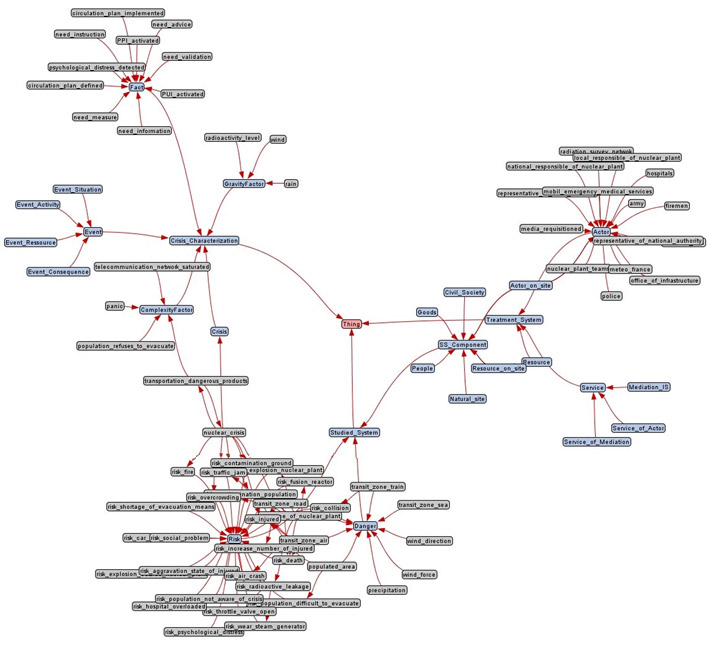
Use Case Diagram / Class Diagram
Figure 11 shows the general use case diagram for the Nuclear Crisis use case. Events are sent to and received from the PLAY system (represented by the upper actor on the diagram). Decisional actors, in the crisis cell, monitor and manage workflows, create new workflows or modify existing ones when needed. They also define priorities. Operational actors execute the requested activities and send back situations reports and diagnosis. Support and consultation actors send diagnosis and measurements.

Scenario description
As explained in section 2.2, to resolve the nuclear crisis, we identified seven business processes, which we divided into three levels (see Figure 12):
- Decisional
- Operational
- Support.
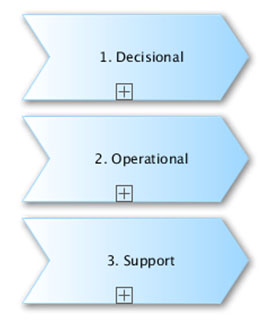
Business processes
As explained in section 2.3.4 (Domain Assumption NuclearUC-DA-03), from the seven business processes identified during the AsIs analysis, we kept only five for the ToBe analysis (see Figure 13, Figure 14 and Figure 15):
1.2 To plan and control relief process and means (decisional)
2.2 To protect population (Operational)
2.3 To provide aid to employees and population (Operational)
3.2 To back relief operations (Support)
3.3 To assess situation (Support)
Indeed, decisions and operations within the plant, to fix the problem, are not managed by the same authority than the rest of the crisis. They also depend on the nuclear plant itself, and the technology it uses. Furthermore, those operations are really technical, not always available, and does not affect the rest of operations (radioactive measurements and previsions are sufficient).
Those business processes are described in detail in the following section.
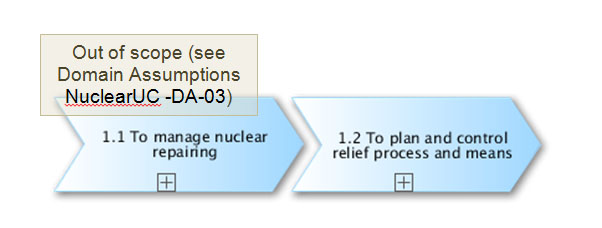

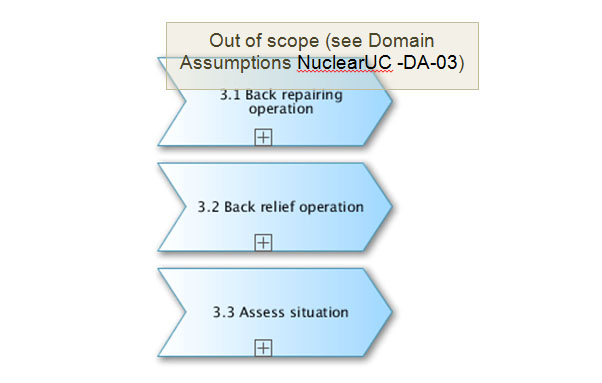
Sub-processes
From those five business process, we have detailed 16 sub-processes (see Figures 16, 17, 18, 19 and 20).
Each of these business processes is detailed according to S-Cube methodology in the following tables.
| Table S1: Scenario NuclearUC_S1_decision1.2 | |
| Field | Description |
| UniqueID | NuclearUC_S1_decision1.2 |
| Short name | To plan and control relief process and means |
| Involved Actors | Prefect (crisis cell)
IRSN (scientific experts) |
| Detailed Operational Description |
|
| Additional Material | Figure 16 (overview)
Figure 21 (BPMN) |
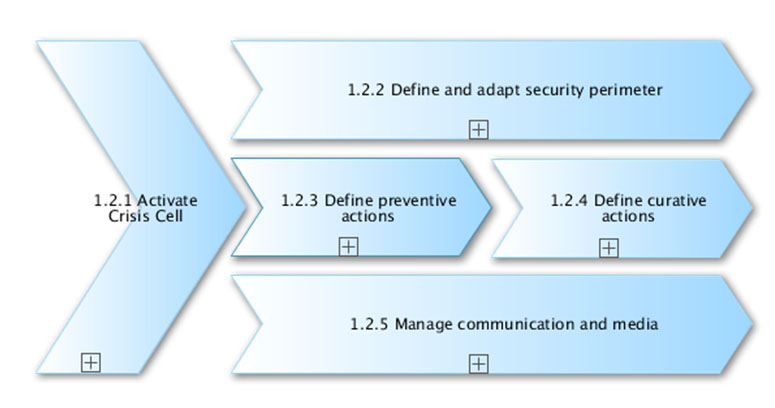
| Table S2: Scenario NuclearUC_S2_operation2.2 | |
| Field | Description |
| UniqueID | NuclearUC_S2_operation2.2 |
| Short name | To protect population |
| Involved Actors | Firemen
Police Army Office of infrastructure Media |
| Detailed Operational Description |
|
| Additional Material | Figure 17 (overview)
Figure 22 (BPMN) |
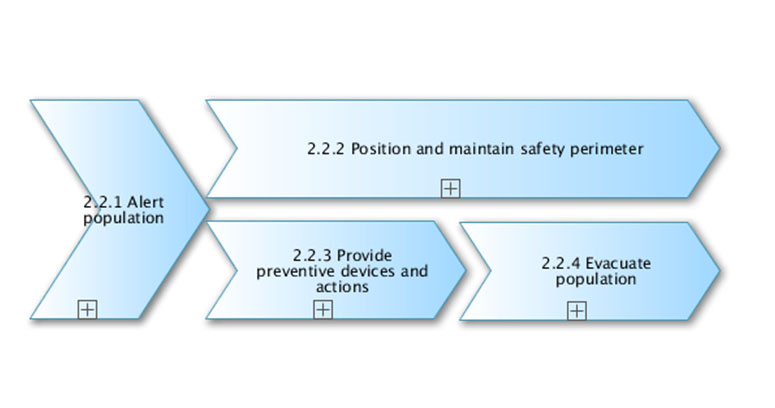
| Table S3: Scenario NuclearUC_S4_operation2.4 | |
| Field | Description |
| UniqueID | NuclearUC_S4_operation2.4 |
| Short name | To provide aid to population |
| Involved Actors | Firemen
Hospitals MEMS |
| Detailed Operational Description |
|
| Additional Material | Figure 18 (overview)
Figure 23 (BPMN) |
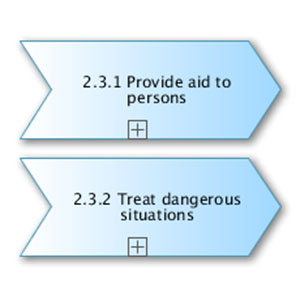
| Table S4: Scenario NuclearUC_S4_support3.2 | |
| Field | Description |
| UniqueID | NuclearUC_S4_support3.2 |
| Short name | To back relief operations |
| Involved Actors | Prefect
Office of infrastructures Logistics section of Firemen Logistics section of Police |
| Detailed Operational Description |
|
| Additional Material | Figure 19 (overview)
Figure 24 (BPMN) |

| Table S5: Scenario NuclearUC_S5_support3.2 | |
| Field | Description |
| UniqueID | NuclearUC_S5_support3.2 |
| Short name | To assess situation |
| Involved Actors | Meteo France
Radiation survey network |
| Detailed Operational Description |
|
| Additional Material | Figure 20 (overview)
Figure 25 (BPMN) |
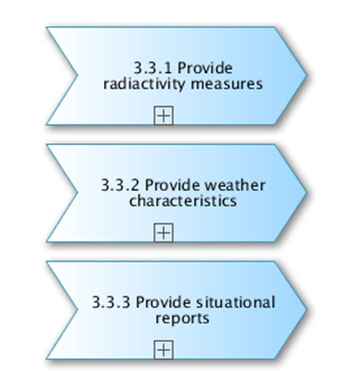
BPMN
The final level of S-Cube scenario description concerns the processes definition. In our case of nuclear crisis management, the scenario is very complex and a lot of sub-processes are involved. As far as we planned to simulate this use case through a demonstration platform able to run (in a SOA context) the three levels of processes (strategic, operational and support), we definitely need to describe these processes and its sub-processes in a very detailed manner.
The demonstration platform that will be provided, it will be based on SOA principles and on the ESB PETALS. Such a technical infrastructure requires describing processes as workflows in a runnable language (for instance BPEL). In order to make that task easier and to ensure coherence into the whole approach, all the sub-processes will be described with BPMN language (Business Process Modeling Notation). Furthermore, this language is not only strongly aligned with computer implementation of workflows but also structurally event-oriented (events are represented through circles and can be typed). BPMN is so perfectly at the intersection between PLAY projects specificities (event-based) and technical requirements of the demonstration platform to be provided (proximity between BPMN and workflow language).
Then, the following figures present different swim lanes (horizontal containers) representing the involved actors and the "clouds". Each pool embeds its own activities and flows, while exchanges between pools are represented through flows generating events. We assume that BPMN is finally the ultimate way to represent detailed processes of our nuclear crisis use-case, through a PLAY point of view (event-oriented) and in a manner perfectly adapted for our perspective of ESB-based demonstration platform.


